< Previous | Contents | Next >
The Tragic Story of the Mills
GONALSTON. It is on the road between Nottingham and Southwell, sheltered by low hills in pleasant countryside where the Dover Beck flows to the Trent.
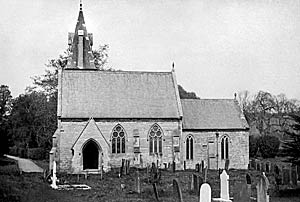
Gonalston church, c.1910.
Opposite its big house a flower-bordered walk leads down to the churchyard, which has a fine avenue of trimmed yew arches and a trickling stream. A tower and spire crown the little church, which was almost all rebuilt last century, and is surprisingly pleasing. Looking out from the hoods of the windows is a gallery of heads; a bearded man and a woman in a wimple greet us at the porch, and a laughing boy with his tongue out is not far away.
Most of the fine grey-walled chancel (built about 1300) still remains, now three steps lower than the rest of the building, and having in its north wall a blocked arch which led to a vanished chapel. The battered Norman font is kept but not used. There is an old pillar stoup, an old oak chest has an iron one for company, and an ancient altar stone belonged to a vanished hospital which stood between the village and Thurgarton. It was founded by William de Heriz, one of a family represented by three figures which were rescued last century from under the nave.
The finest of the three is of a beautiful woman wearing a draped mantle and a square headdress which shows her lovely hair and falls in rich folds to her shoulders; a dog is at her feet, and over her head is a splendid canopy. She was Matilda de Heriz, heiress of the last of the family, who died about six centuries ago. Near her lies a worn knight in chain mail, with a close-fitting helmet, a sword, and a broken shield; his legs are crossed, and his feet are on a lion. He may be John de Heriz of 1229, and the other knight in chain mail, also with a lion at his feet, is perhaps John de Heriz, who died a hundred years later.
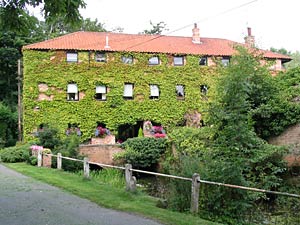
Gonalston Mill in 2006.
Between the village and Lowdham, where the road is a tunnel of living green, is a gaunt old mill by the Dover Beck, bringing to mind a tragic tale. The mill is one of many turned by this stream in days gone by, and in the bad old days of child slavery waifs were sent to them from London. From St Pancras workhouse in 1799 about 80 wretched little ones came down to one of the mills here, and the experience of one of them who survived, though crippled and deformed by the life, is on record in a pamphlet called the Memoir of Robert Blincoe.
Robert was seven when he left the workhouse with the rest of the children, eager for the happy change of life that was promised them, but finding only too soon that roast beef, plum puddings, and rides on the master's horse became in actual experience daily toil of 14 or 16 hours at the machines, with thrashings for being too small to reach the work, and always insufficient food.
The children were apprenticed to the mill owner till they were 21, but many died long before their time was up. Often their fingers were bruised and maimed by being caught in the mill, and when Blincoe lost the forefinger of one hand a surgeon put the joints together and sent him back to work. Once he tried to escape, but was found, brought back, and beaten, while the finder went off with five shillings reward—singing hymns.
But all this was gentle treatment compared with the treatment at Litton Mill, near Tideswell in Derbyshire, where they were sent to finish their time after the Lowdham mill closed down. At Litton Mill, which belonged to a magistrate, the day began at five o'clock with a horse-whip in the sleeping quarters, and continued under conditions of unthinkable horror. Slow starvation, filth, and brutality led to broken spirits, fevers, and death, until the millowner thought it wise to bury the dead in different churchyards to hide their ever-growing numbers.
So this old mill in this country lane brings to mind the thought of the slavery endured by our little ones at home even while our poet Cowper was writing "Slaves cannot breathe in England" and our statesmen were setting free the slaves abroad.
Merrie Tales of Gotham
GOTHAM.
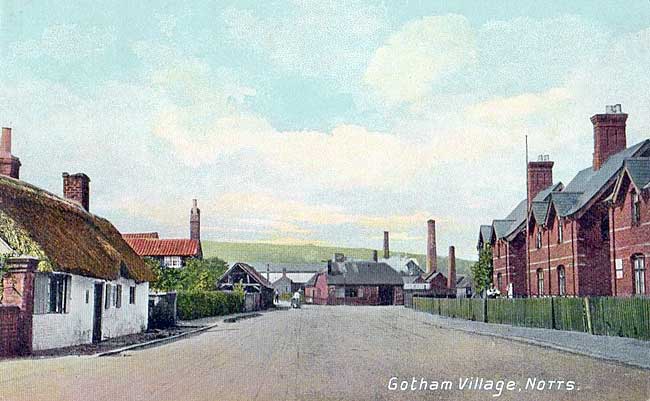
Gotham village in the early 1920s.
A commonplace village with its mining and plaster works, it has beauty on the hilltops, where the woods are richly carpeted with bluebells, and there are charming views towards Belvoir. It has an ancient church, an old well and a name which has been for centuries a household word to all who love a merry tale.
For Gotham was the home of the folk who did the simple silly things which brought much laughter into the world when the Merrie Tales of the Mad Men of Gotham were printed in the 16th century. Who has not heard of the Wise Men who tried to drown an eel in a pond, who burned down a forge to get rid of a wasp's nest, built a hedge round a cuckoo, and sent cheeses rolling downhill to go their own way to Nottingham?
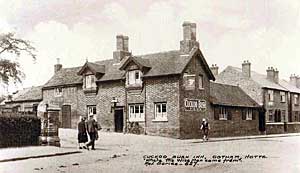
The Cuckoo Bush Inn in the 1930s.
There is no pool now to lend colour to the stories, and the old forge is gone; but Cuckoo Bush Hill and the Cuckoo Bush Inn are here still, and the Cuckoo Bush Mound, with tall trees rising from an ivy carpet, is set in a dense wood where the Wise Men might almost be forgiven for thinking they could keep the cuckoo captive. Not far from Cuckoo Bush Wood is Crow Wood Mot which takes us back a thousand years and more to the time when Saxon chieftains sat in judgment at the gatherings of the Hundred of Rushcliffe.
For five centuries Gotham has had a place in literature as the home of the men supposed to be capable of the maddest follies. As early as the 15th century the village was enshrined in the famous Townley mystery plays, where we see the village sages planting a hedge round the cuckoo so that it may sing for them all the year, and the village genius riding to market with two bushels of wheat, carrying the burden round his own neck so that his horse shall not have to bear the load. But it is believed that the Tales of Gotham are much older than the 15th century, for one explanation of them is that the Men of Gotham were not so mad as some of us imagine, but that they pretended to be a collection of fools in order to keep King John away, either because he was contemplating buildingahunting lodge among them or because of the superstition that the ground which a king passed over must ever after be a public road. It was felt that if the king's messengers found nothing but fools in Gotham the king would not choose to live among them and all would be well.
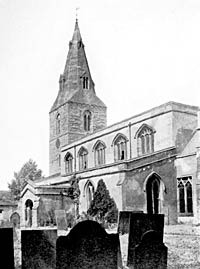
Gotham church in the 1920s.
The old village church had been restored when we came, and the stone of the inside walls shines with the fresh bloom of youth. It is chiefly 13th and 14th century, and has an unbuttressed tower and a sturdy broached spire of peculiar interest. They are believed to have been built from base to summit at one time, in the 13th century, the spire being one of the earliest stone spires in the country, and the only one in Notts to follow the design of the ancient wooden ones. It has two tiers of lights, and springs from a corbel table, its upper part having been made new. A 15th century clerestory crowns the nave with its arcades of the 13th and 14th centuries. One of the older capitals is entwined with foliage springing from four heads.
Of two monuments to the St Andrew family, who knew the village from the 13th to the 17th century, one has kneeling figures of William, his two wives, and their four children; the other shows John St Andrew of 1625, the last male of his line, kneeling with his wife under a canopy. With them are three daughters and a pretty babe in a cradle, the only son, who died 14 days old.
The chancel is striking with colour—a red and white panelled roof crowning grey walls and blue furnishings. The new east window frames an Easter morning scene in rich colours, with the three Marys and the angel at the tomb.
